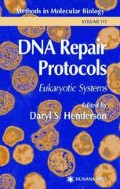Abstract
Apurinic/apyrimidinic (AP) sites are one of the more common lesions formed in DNA that, if left unrepaired, can represent potential sites of mutation (1). To illustrate the importance of these sites, all organisms that have thus far been tested have been found to contain enzymes that incise abasic sites to initiate the repair process. Generally, these enzymes fall into two categories. The predominate AP endonuclease, at least quantitatively, is one that hydrolytically cleaves 5′ and adjacent to an AP site (Fig. 1), producing nucleotide-3′-hydroxyl and 5′-deoxyribose-5-phosphate termini (2). The other class of enzyme that acts at AP sites is part of a base excision repair pathway that is initiated by an N-glycosylase activity directed toward a modified or nonconventional base in DNA. Some of these N-glycosylases also possess AP lyase activity that cleaves DNA 3′ to an AP site via a β-elimination reaction to leave a 3′ 4-hydroxy-2-pentenal-5-phosphate (Fig. 1). An example of this is endonuclease III in Escherichia coli, which is a broad specificity enzyme for the repair of oxidative damage to DNA. Other N-glycosylase/AP lyase repair proteins not only cleave 3′ to an AP site, but follow this with a δ-elimination reaction to remove the AP site and leave 3′- and 5′-phosphate termini (Fig. 1). An example of this type of enzyme is the E. coli Formamidopyrimidine glycosylase (Fpg), which catalyzes a concerted β, δ-elimination reaction (3). Another example is Drosophila S3, but in this case, after catalyzing a β-elimination reaction, it appears as if the S3 protein dissociates from the AP substrate, and on a second encounter with the substrate, catalyzes a δ-elimination reaction (4).

Cleavage sites for AP endonucleases/lyases. The 5′-end is labeled P*, CHO represents the AP site that is cleaved either hydrolytically (hyd) or by a β-elimination reaction, and in some cases, by an additional δ-elimination. For convenience only one strand of the duplex is depicted.
Access this chapter
Tax calculation will be finalised at checkout
Purchases are for personal use only
References
Loeb, L. A. and Preston, B. D. (1986) Mutagenesis by apurinic/aprimidinic sites. Ann. Rev. Genet. 20, 201–230.
Doetsch, P. W. and Cunningham, R. P. (1990) The enzymology of apurinic/apyrimidinic endonucleases. Mutat. Res. 236, 173–201.
Bailly, V., Verly, W. G., O’Conner, T., and Laval, J. (1989) Mechanism of DNA strand nicking at apurinic/apyrimidinic sites by Escherichia coli [formamidopyrimidine] DNA glycosylase. Biochem. J. 262, 581–589.
Yacoub, A., Augeri, L., Kelley, M. R., Doetsch, P. W., and Deutsch, W. A. (1996) A Drosophila ribosomal protein contains 8-oxoguanine and abasic site DNA repair activities. EMBO J. 15, 2306–2312.
Spiering, A. L. and Deutsch, W. A. (1986). Drosophila apurinic/apyrimidinic DNA endonucleases. Characterization of mechanism of action and demonstration of a novel type of enzyme activity. J. Biol. Chem. 261, 3222–3228.
Wilson, D., Deutsch, W. A., and Kelley, M. R. (1994) Drosophila ribosomal protein S3 contains an activity that cleaves DNA at apurinic/apyrimidinic sites. J. Biol. Chem. 269, 25,359–25,364.
Levin, J. D. and Demple, B. (1990) Analysis of class II (hydrolytic) and class I (β-lyase) apurinic/apyrimidinic endonucleases with a synthetic DNA substrate. Nucleic Acids Res. 18, 5069–5075.
Lindahl, T. (1980) Uracil-DNA glycosylase from Escherichia coli. Methods Enzymol. 65, 284–295.
Bailly, V. and Verly, W. G. (1987). Escherichia coli endonuclease III is not an endonuclease but a β-elimination catalyst. Biochem. J. 242, 565–572.
Yacoub, A., Kelley, M. R., and Deutsch, W. A. (1996) Drosophila ribosomal protein PO contains apurinic/apyrimidinic endonuclease activity. Nucleic Acids Res. 24, 4298–4303.
Author information
Authors and Affiliations
Editor information
Editors and Affiliations
Rights and permissions
Copyright information
© 1999 Humana Press Inc.
About this protocol
Cite this protocol
Deutsch, W.A., Yacoub, A. (1999). Characterization of DNA Strand Cleavage by Enzymes That Act at Abasic Sites in DNA. In: Henderson, D.S. (eds) DNA Repair Protocols. Methods in Molecular Biology™, vol 113. Humana Press. https://doi.org/10.1385/1-59259-675-4:281
Download citation
DOI: https://doi.org/10.1385/1-59259-675-4:281
Publisher Name: Humana Press
Print ISBN: 978-0-89603-802-8
Online ISBN: 978-1-59259-675-1
eBook Packages: Springer Protocols

